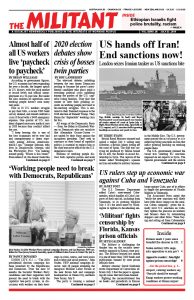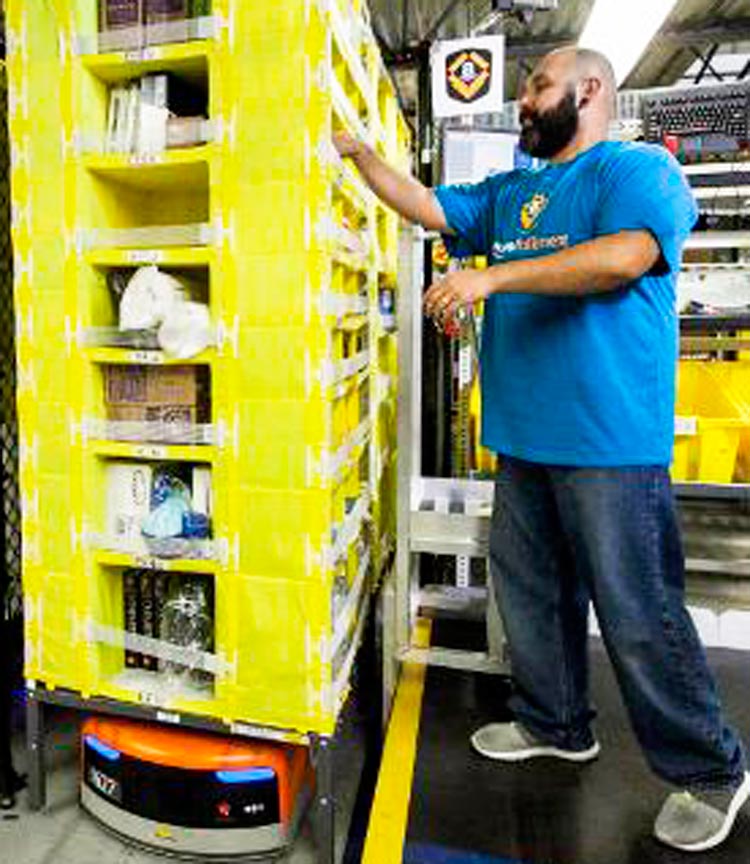According to government figures, the U.S. economy has been expanding for over a decade, the longest uptick in U.S. history, with the stock market at record levels and official unemployment at a 50-year low. But under the class realities of capitalism, most working people haven’t seen many real gains.
Four in 10 U.S. workers struggle to pay their bills, a recent UBS bank survey showed, and would confront a crisis if faced with a $400 emergency expense. One quarter of U.S. residents skipped necessary medical care in 2018 because they couldn’t afford the cost.
“I keep hearing this is one of the best economies we’ve ever had and unemployment is down especially among African Americans, which I am,” Sommer Johnson, who lives in Douglasville, Georgia, told the Washington Post. “I’m looking around going, ‘Where is this boom?’ From where I sit, this doesn’t look like the best economy ever.”
U.S. workers have faced stagnant wages for decades, and got slammed during what the capitalist pundits call the 2008 “Great Recession.” At the same time they’ve been hit with rising expenses for housing, health care and education — and now record levels of personal debt.
After adjusting for inflation, 50 percent of U.S. households have less income today than they did 30 years ago, the Federal Reserve Bank reports. While more jobs are available today, increasing numbers of workers are forced to work two or even three jobs to make ends meet. Wages are less than $18.58 an hour for half of all U.S. jobs, and more than a third pay less than $15. Some 4.3 million workers seeking full-time jobs are forced to accept part-time hours, the government admits.
Speed up and longer hours
At the same time, many bosses push those who do have jobs to work faster and for longer hours. Nurses, for example, are being overworked to the detriment of their own health and care for patients. With daily workshifts of 12 hours or more, 31 percent of nurses show symptoms of chronic insomnia, according to a recent study by the Associated Professional Sleep Societies. Some 13% of nurses say they have to rely on medication to help keep them awake. Similar conditions affect railroad workers, who say fatigue is a constant threat.
Other employers are trying to use technology to squeeze superhuman productivity by ramping up the pace of work. Robotic storage cubicles that swarm around the 2,500-worker Amazon warehouse on Staten Island in New York bring goods for pickers to pack at breakneck speed, raising the rate from 100 items an hour to between 300 to 400.
“We try to eliminate any wasted motion,” one picker-trainer told the New York Times. “If you have one second that’s adding to the process, it doesn’t seem like a lot. But if you do that 1,000 times a day, that’s when it starts adding up.”
Debt explosion
Under these conditions, more and more workers face mounting debts. There’s a lot of press about student loan debt, and the 24 competing Democratic presidential candidates argue about whether they can cancel student debts, but the fact is there’s a steadily mounting debt burden of all kinds facing workers and farmers today.
Total U.S. household debt in the first quarter of this year reached a record level of $13.7 trillion, the Federal Reserve Bank of New York says. A rising component of this is car loans, with auto finance companies pushing subprime loans, which involve low down payments and high interest rates that many working people can’t keep up with.
The number of people “seriously delinquent” on car loan payments rose to the highest level on record in 2018 — 7 million people, a million above the previous peak in 2010.
Dairy farmers are facing unprecedented pressure to fold up shop, as their income has been squeezed to below zero by the seed and fertilizer monopolies, processors and banks.
This spiraling debt has spawned one seriously expanding capitalist job category — the repo man.
The number of debt collection hounds is exploding and lawsuits by these agencies are boosting their profits on workers’ misery. Debt-claim suits rose 29 percent in Texas last year to 214,000 cases. In New York City court filings rose 32% in 2018 and 61% in 2017.
And today’s laws allow the leeches to garnish your wages — often without you even knowing they’re coming — and to slap liens on any property you’ve managed to acquire.
These collection outfits purchase packages of consumer debts, paying a few pennies on the dollar, and then pursue borrowers with fervent gusto for the face value of the debt plus interest, which may have accumulated for over 20 years.
One example of how this works was described in a July 5 Wall Street Journal article titled “Debt Collectors Wage Comeback.” Debt-buying company AM Solutions LLC sued Philadelphia couple Adolph and Doris Muir in 2017 to foreclose on the couple’s home and collect more than $83,000 for what the company claimed was defaulting on a $6,500 mortgage in 1983.
But, as the Muirs tried to explain, the fact was they paid $4,500 cash for the house in 1978 and never took out a mortgage on it. The debt thieves got the story wrong. But for 15 months the Muirs faced the threat of eviction, and faced the expense of hiring lawyers, while the courts pondered over the case. Eventually the court said they were right.
Others aren’t so lucky. Many cab drivers in New York took out loans to pay hundreds of thousands on medallions to own and operate cabs, promised lifetime returns and a happy retirement. But with the steep increase in competition that has exploded from Uber and other app-based for-hire cars, the medallions today are virtually worthless. And the competition means Uber drivers find it very hard to get by as well. The resulting debts have led to a rash of driver suicides.



